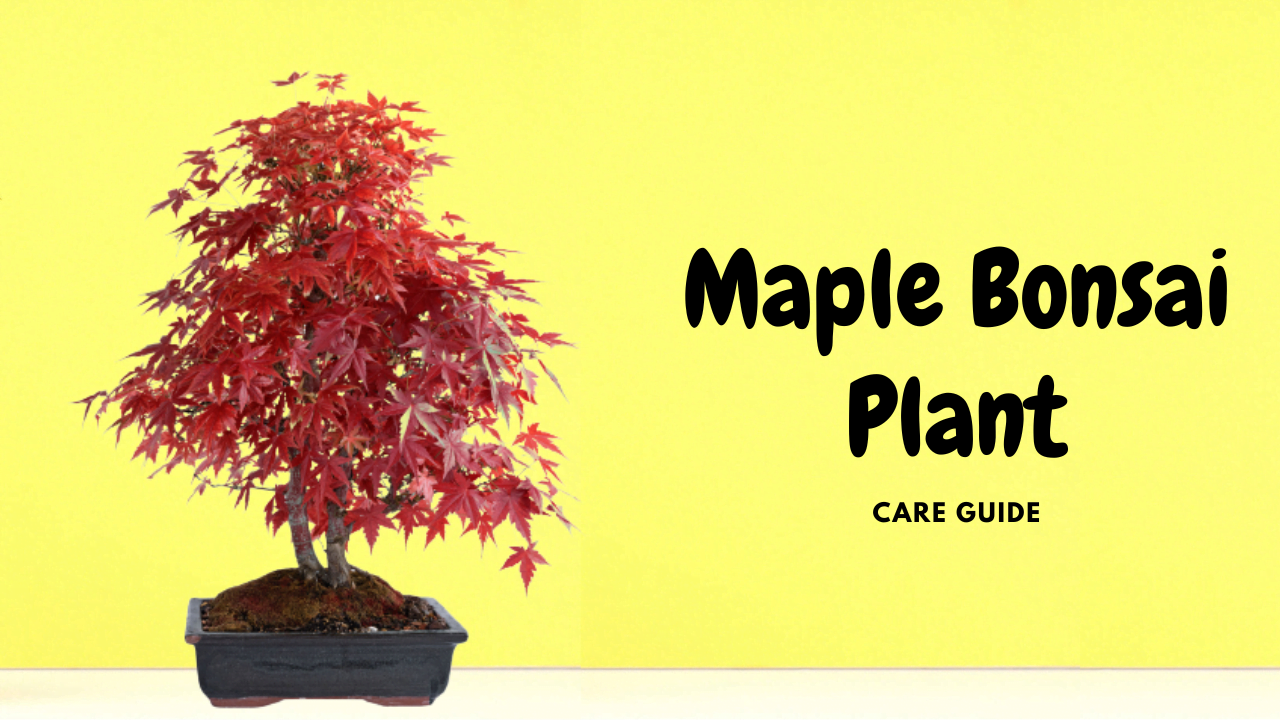Maple Bonsai Plant Overview
Japanese Maple Bonsai Trees are best known for their unique leaf shape and seasonal changes. Due to their deciduous nature, maple trees lose their leaves during the winter and sprout back during the spring. It is a highly recommended type of bonsai tree for those individuals who are just starting the bonsai tree hobby. The Japanese Maple bonsai tree does not require a lot of maintenance and care.
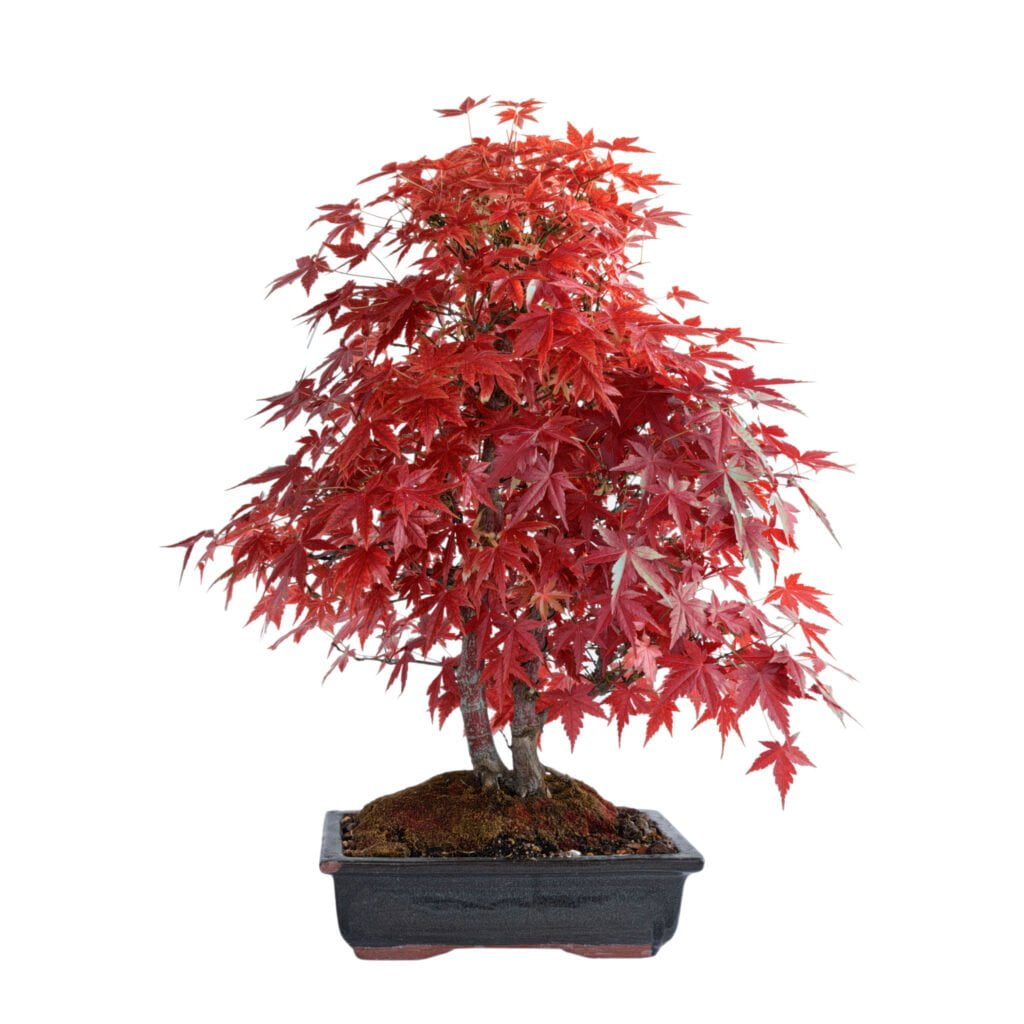
Things to Care
● The Japanese Maple prefers a sunny, airy position but during great midday heat it should be placed in the light shade to prevent damaged leaves. If placed in full sun, take care to manage your watering to prevent your tree from drying out. Also, full sunlight and warmer conditions can lead to some leaf burn.
● While 2 to 4 hours of morning direct sunlight is highly beneficial in maintaining the red pigment of Japanese Maple trees with red leaves, they prefer a late afternoon or evening dappled shade.
● A Japanese Maple in a Bonsai pot must be watered daily in most cases during the growth season, maybe even several times a day during the hottest days.
● Feed the tree every two weeks during spring and summer. During the fall, feed the tree with a fertilizer that is nitrogen-free.
● To reduce the size of leaves, prune the leaves during periods of active growth. This will also serve to intensify the colors of the leaves in the fall. Pinch- out new tree shoots on a regular basis to maintain the desired style, and to encourage optimal branching.
● Re-pot young trees once a year. Re-potting must be carried out in the springtime prior to the opening of the buds. After repotting, place the tree in a shaded area for 2-3 weeks prior to placing back in full or partial sun. Maples prefer more acidic soil.
● Provide excellent air circulation to the plant so as to prevent powdery mildew.
● Keep the leaves free from dust and inspect regularly for pests or fungus.
NOTE: As it is a live plant, therefore its health might deteriorate because of shipping. Hence you are advised to allow the plant to recover to its best of health within 1-2 weeks of the receipt. These are a few points which will help you to take care of your plant.
These were some basic care tips for Japanese maple bonsai. However, while growing maple bonsai, there are a few other things you have to watch out for. So, let’s take a closer look at some maple bonsai problems and solutions.
Maple Bonsai Care – Common Problem & Solutions
As with any bonsai plant, the Japanese Maple is susceptible to many diseases and pests. Hence, it is essential to take proper care of this delicate plant. To do so, you must be aware of the following common problems and their solutions.
1. Mold spots on maple bonsai
It is a fungus that regularly harms and spreads rapidly. Also, there is a good chance that this fungus is to blame if you notice any brown or gray spots. If you ignore these warning signs, your plant may die.
Solution: In most cases, it is caused by overwatering Japanese maple bonsai. So, firstly, remove all infected parts of the plant. Then, take off any roots and leaves that are infected. Lastly, repot your plant using fresh soil.
2. Root rot in Japanese maple bonsai
The fungal pathogens pythium, fusarium, and verticillum cause root rot in Japanese maple trees. When the soil is saturated and overly wet for an extended period, these pathogens can survive and develop.
If the roots appear waterlogged or rotten, the pathogen is destroying the tree’s roots. Also, it is possible to find reddish-brown cankers in the soil around the root system.
Solution: A Japanese maple bonsai need proper care to avoid disease and stress. While Japanese maple trees are hardy and adaptable to poor soil conditions, providing them with optimal growing conditions reduces disease and decline risks.
So, keep the soil moist, fertile, well-draining, and organically rich to support trees. Furthermore, Japanese maple trees prefer acidic conditions. Following these right conditions will prevent root rot and make your tree healthy and vigorous.
3. Maple bonsai leaves turning yellow
In the gardening world, yellow leaves are the most common problem. There are two main causes of this problem: overwatering and nutrient deficiency.
Solution: Reduce your watering frequency, or fix a potassium or nitrogen deficiency. Additionally, you can buy special soil for your plant deficiency. Moreover, a garden center consultant will be happy to help you with this information.
4. Sunburned maple bonsai tree
Sunburn on Japanese maple bonsai is easy to determine. The color of your plant will change, either turning yellow or white.
Moreover, browning leaves are a classic sign of overexposure to direct sunlight and sunburn. The plant will not die, but it will grow adversely.
Solution: Fortunately, the remedy is as simple as moving your Japanese maple bonsai out of direct sunlight. With this strategy and appropriate watering, your plant should quickly rebound.
5. Wilting or drooping bonsai leaves
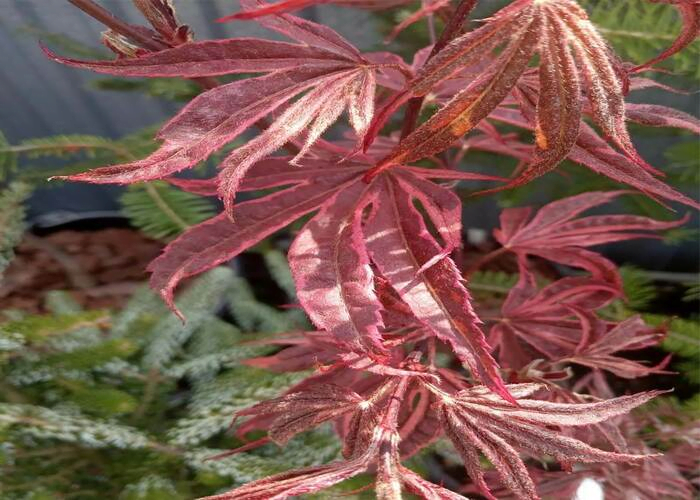
This usually happens when your maple bonsai lacks water. It is especially true for large plants, which naturally need more water.
However, using a balance scale, you can determine if your bonsai plant needs water by underweighting it. If the pot seems light, the soil and roots are probably very dry.
Solution: If the soil in your pot is completely dry, you must moisten it first to ensure that the water reaches the roots. Also, a common mistake is drowning the Japanese maple bonsai right after a dry period. Giving too much water at once will end it most easily. Instead, water the soil peacefully and return to your normal watering rhythm.
Japanese maple bonsai: Pests
1. Pseudomonas syringae
Japanese Maple bonsai are most commonly affected by Pseudomonas syringae. This pest thrives on plants that have suffered damage previously. You can see spots on the leaves while the veins are darkened.
Solution: Pseudomonas syringae is commonly controlled by spraying bactericides. Some of these include copper compounds or other heavy metals, along with fungicides or other pest-control chemicals.
2. Aphids
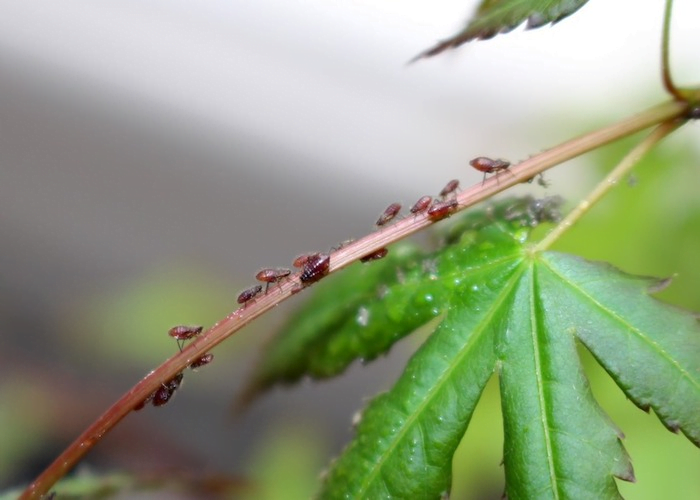
Japanese maple leaves are often infested with sucking pests called aphids. It is difficult to identify these insects because they are relatively small. These insects take nutrients from leaves, causing them to fall off.
Moreover, a large number of leaves are usually affected at once as a result of this infestation. Thus, the canopy volume is reduced and leaf brilliance is minimized.
Solution: The best way to get rid of these pests is to spray cold water on them. Also, using flour prevents rapid reproduction and constipates pests. Additionally, you can spray the plant with insecticidal soap or horticultural oil.
3. Scale

This is a very common, and hazardous, pest of Japanese maple bonsai. Their tops are covered with a white armored crust, within which pests hide. On the stems and dark bars, their white armors are easy to spot. During extreme infestations, the leaves will start wilting before they should, the bark will dry, and the plant will die.
Solution: Scales ingest the toxic insecticide when they feed on sap and are killed. Three most commonly used systemic insecticides are effective against scale: acephate, imidacloprid, and dinotefuran. Mix the insecticide with water and apply it to the plant’s base
Japanese maple bonsai: Diseases
1. Verticillium Wilting
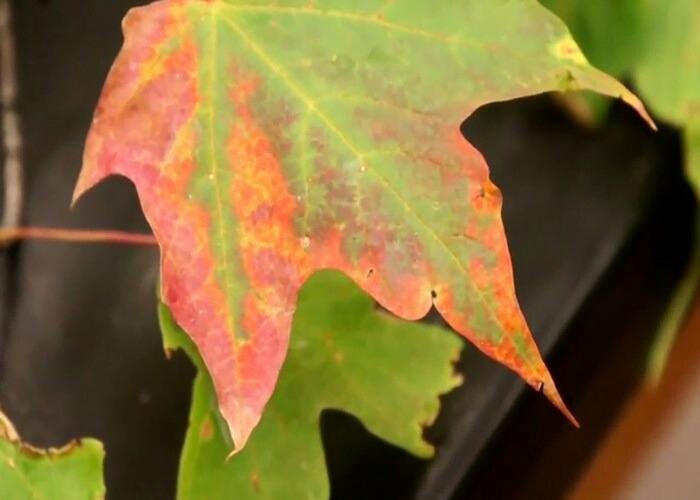
It is one of the most concerning problems with Japanese Maple. The first symptom is discoloration of leaves. As it spreads, it will affect other healthy leaves on the same branch. If not removed immediately after noticing the symptom, the maple bonsai will not last long.
Solution: Once Verticillium wilt enters the plant, it cannot be cured. It’s better to destroy small, easy-to-replace plants. Also, in the same area, don’t plant another susceptible species, as the disease remains in the soil after removing the plant.
2. Anthracnose
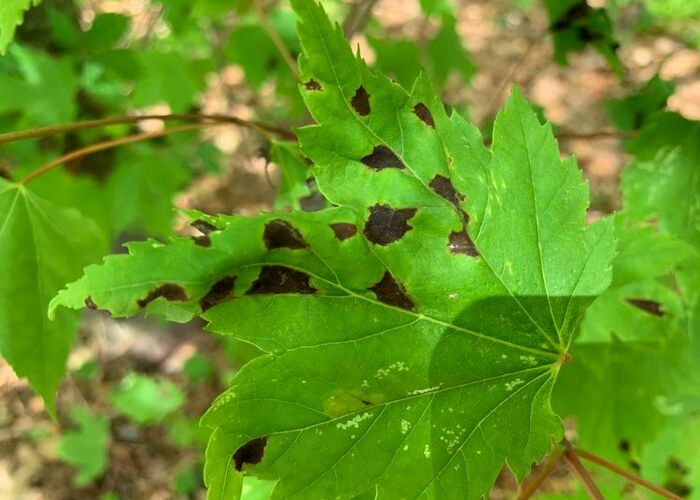
During the rainy season, anthracnose is usually caused by high humidity. In this case, fungi attack the leaves and stems, causing spots. Despite pruning, the fungus will remain on pruned leaves and stems. Thus, they thrive before releasing spores. In other words, if one leaf of the Japanese Maple is affected, all other parts will be affected as well.
Solutions: Ensure that all infected plants in your garden are removed and destroyed. Remove dead wood from trees and destroy infected leaves. Spray your plants with a copper-based fungicide. However, be careful as copper can build up in the soil to toxic levels for earthworms and microbes.
3. Powdery Mildew
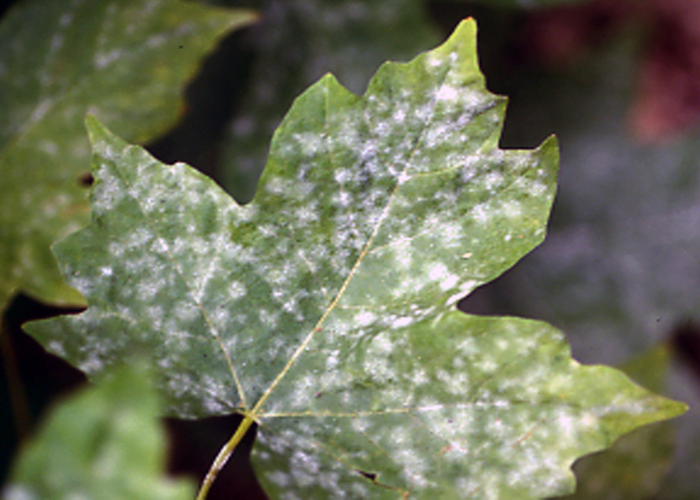
Almost all Japanese maple bonsais are affected by this disease. There is a white, powdery layer on top of the leaves due to mildew fungus. In humid areas or direct sunlight, powdery mildew is ten times more likely to occur.
Solution: Powdery mildew can be treated with baking soda. Mix 1 teaspoon of baking soda with 1 quart of water. Just make sure you spray plants thoroughly since the solution will only kill the fungus that comes in contact with it. Another good home remedy is milk spray.
When should I fertilize my maple bonsai tree?
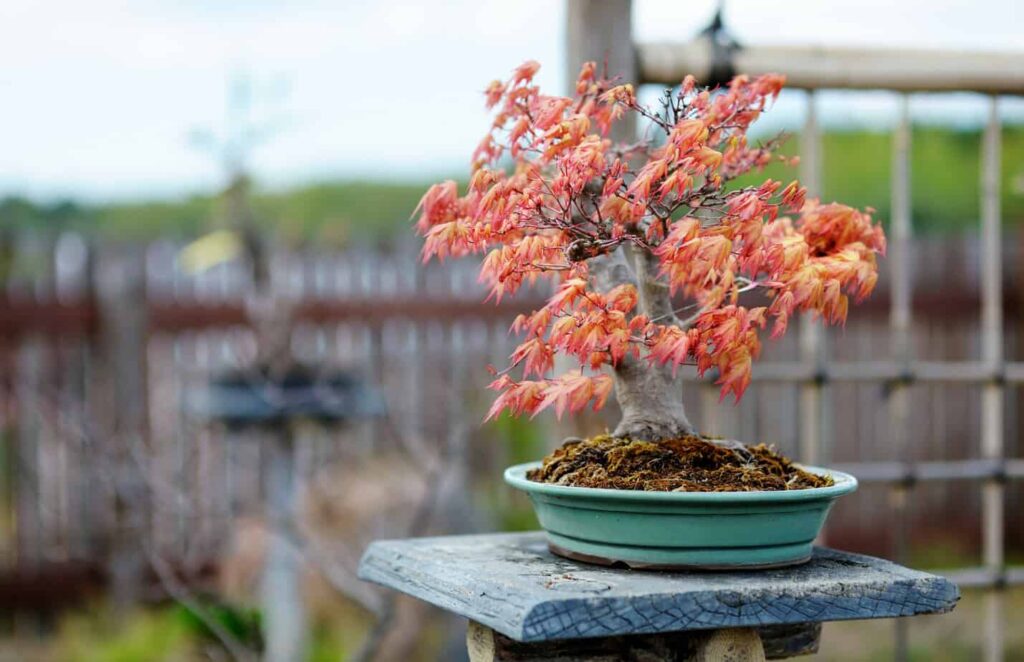
You should feed your Japanese Maple Bonsai every other week during spring and summer with organic Bonsai fertilizer. In the fall, switch to a nitrogen-free fertilizer and reduce feeding.
Don’t use quick-release fertilizer. Choose a controlled or slow release. To prevent shock, avoid feeding for several weeks after repotting.
Moreover, the Japanese Maple benefits from regular fertilizing. Yet, wait until your Japanese maple is one year old before fertilizing.
What is the best fertilizer for maple bonsai?
Nitrogen is one of the best fertilizers for maple trees. For the fast and healthy growth of maple trees, high nitrogen fertilizers are essential. The ideal fertilizer for maple trees consists of nitrogen, phosphorus, and potassium.
What soil is best for maple trees?
For Japanese Maple Bonsai to flourish, well-draining soil with a pH of 5.5 to 6.5 is necessary.
To make sure that your Japanese Maple grows well, plant it in a Bonsai soil mix. These soil mixes are specially formulated to make sure that your Bonsai grows well. The soil must cover the tree’s roots. Besides that, the planter must have enough room for roots to grow.
From our store, you can buy bonsai soil as our soil mix is specially prepared to support bonsai tree growth. Furthermore, you can avoid waterlogging by adding rocks or stones to the bottom of your Japanese maple bonsai tree pot. Additionally, put shredded bark around your trees, preferably from hardwoods. This will keep the roots safe. You can speed up the tree’s growth by adding coffee grounds to the soil.
When should I re-pot my maple bonsai?
It is best to repot maple bonsai in the spring, accompanied by root pruning, as roots can grow fairly quickly.
Moreover, it’s OK to remove all the original soil when repotting as these species are pretty hardy. Also, you can cut up to 50% of the roots without weakening them.
You can use a soil medium that retains water, such as Aoki Blend or a 2:1:1 mixture of akadama, lava rock, and pumice. Generally, the particle size of soil should be about 3/16 inch (4mm) for medium and large trees, and slightly smaller for shohin trees.
Also, re-potting is necessary every 1 to 2 years for young Japanese maples under 10 years of age. The more mature plants should be re-potted every 2-3 years. Moreover, it is important to remove half the roots’ length, especially for younger bonsai.
The roots of Japanese species are shallow, so they can fit into shallow pots, but they grow vigorously when planted in large pots.
Why is my Japanese Maple Leaves Curling?
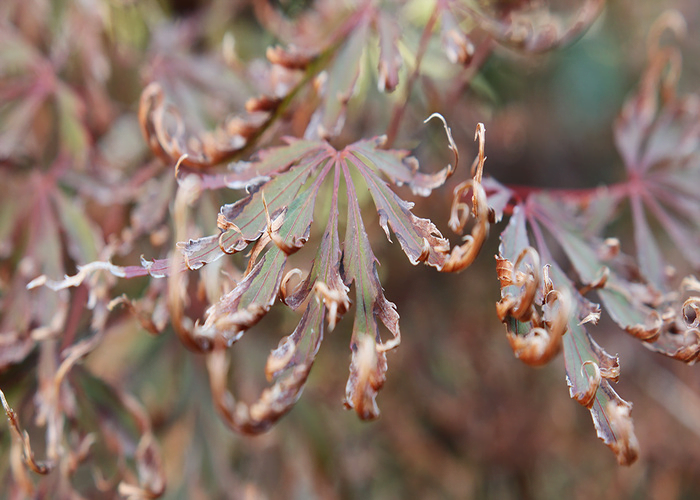
Japanese Maple leaves can curl due to environmental factors such as too much sun or temperature stress. Additionally, improper watering, diseases, pests, and climate can cause curling maple bonsai leaves.
The following sections provide detailed information about each case. Additionally, you will get advice on how to fix the issue.
1. Underwatering Japanese maple bonsai
Underwatering is the first cause of curled leaves. Most of the time, this occurs in hot, sunny weather. Additionally, the hot wind makes things worse.
This will cause the leaves to curl inward and perhaps burn at the edges. However, you can still fix this problem if you notice it in time.
How to fix: Water the maple thoroughly, it should soak up the water. When the soil dries 1-2 inches deep, water again.
Lack of water often causes maples to twist. This rarely happens to trees with heavy roots. Also, potted maple trees tend to curl. Because hot weather dries out the potting soil fast. Hence, keep an eye on potting soil moisture or transplant maple outside.
2. Bonsai curled leaf due to disease
The first thing to mention here is anthracnose. We have seen in the above section that it’s caused by different pathogens. Moreover, it poses a serious threat to young trees.
As soon as the disease begins, the leaves curl and have dark spots on them. Unless the disease is treated, the leaves will shrivel and fall off the young branches. It rarely kills maples. However, it can severely damage young trees.
How to fix: Make sure that the maple gets enough light. Also, make sure that the air is freely flowing around the tree. Consider transplanting it to a more open location if necessary.
To prevent further damage, spray the maple with a fungicide. Spray again after a while. Some cases may need multiple sprayings.
Also, stop overwatering maples. Additionally, don’t direct your sprinklers toward the leaves if you have automatic watering.
3. A sudden change in temperature
Sometimes the daytime air temperature is really high, and the evening air temperature is very cold. As a result, leaves curl up to stay warm. Also, some leaves turn red or purple.
These sudden temperature changes usually occur in late spring or early summer. Those growing in pots or young maples are most susceptible. Although maples won’t get serious damage, twisted leaves may stay for the entire season.
How to fix: In general, you shouldn’t do anything, the tree will recover after a while. However, you can help your maple by watering it regularly. Then, water the maple with multipurpose liquid fertilizer. It will only take one watering with liquid fertilizer.
Additionally, you can shade the maple bonsai for a few weeks with a garden umbrella. It will be easier for your bonsai to recover from temperature stress if you reduce sun exposure.
4. Too much watering
Heavy rains or too much water can curl maple leaves. Also, this does not mean that Japanese maples will tolerate excessive watering.
If roots receive too much water, they lack oxygen and begin to rot. There will be yellowing and curling on the maple leaves.
How to fix: First thing, stop watering. Let the maple dry out for 2 inches before watering. You will get a bonsai tree back to normal if you notice the problem early and stop watering.
Also, you should transplant the maple bonsai if it lives in wet soil all the time. Use well-drained soil when replanting. Additionally, fill the planting hole with stones for drainage.
5. Too much sun
Too much sun is another reason. During the early spring, when leaves are unfolding, the weather can be cloudy. Then, all of a sudden, it gets sunny and hot. Normally, leaves that don’t get direct sun curl inward to avoid getting burned.
Also, there can be browning of the leaf edges or brown spots in the center of the leaf. Usually, curling begins at the tips of the leaves. Moreover, it is more common for twisting to occur in hotter climates because of the strong sun.
How to fix: In this situation, the maple would benefit from shade. However, do not completely shade it, the maple still needs early morning sun. You can remove the shade when the curling stops.
Also, it is difficult to shade a maple that is already big. Only a little more water will help here but don’t overwater the maple. It won’t matter if the tree is damaged, it will eventually recover.
6. Using the wrong fertilizer
Your maple leaves may curl and droop if you have fed them a lot of mineral fertilizer. Nitrogen excess is the primary cause. As a result, the plant may grow vigorously, but its leaves and branches will not mature properly. This leads to soft, twisted leaves.
There is nothing you can do to change this situation. However, don’t overfeed maple trees in the future.
The second scenario is when the soil lacks the necessary elements. This is about magnesium. For photosynthesis, this element is essential. Most soils have enough, but if the soil is very alkaline, it won’t be there.
How to fix: Whenever maple leaves curl and turn yellow, but their green veins remain visible, it is probably chlorosis. With the help of acidifiers available at garden supply stores, you can acidify the soil. Also, use a slow-release multipurpose fertilizer no more than once a year on the maples. Do this at the beginning of the season.
7. Japanese maples infested with pests
Insects can also cause maple leaf curl. You might not even notice them, but if there are a lot of them, it can seriously damage your bonsai maple. Especially, your young maple bonsai tree is at risk.
There are two types of pests: branch-eating insects and leaf-eating insects. Among the most common insect pests are aphids. This insect sucks sap from leaves by attaching itself to its lower parts.
Second, there are spider mites. These tiny insects weave cobwebs on their leaves and branches on maple trees. They cause the leaves to curl as they stick to the tree.
How to fix: Spray horticultural oil or another insecticide on your maple tree to get rid of aphids. Single spraying of these insecticides will usually eliminate the aphids. Furthermore, the best way to get rid of spider mites is to use a special product called acaricide.
8. Bonsai transplant shock
Due to sudden changes in growing conditions, maples begin to stress after planting in a new location. The Japanese dwarf maple is particularly susceptible to this problem.
How to fix: If you want to avoid transplant shock, plant maples in early spring before they begin to grow. When transplanting, avoid damaging the roots. In the event of transplant shock, shade the maple if possible. Additionally, keep the soil moist and water the maple in time.
9. Damage caused by herbicides
If you spray weed killer on your lawn, drops can often get on the leaves of Japanese Maple. This causes the leaves to curl and turn brown. Eventually, the leaves will fall off.
If you didn’t treat your lawn, your neighbors might have. Wind may have brought a small amount of herbicide to your maple bonsai.
How to fix: Wash off any herbicide residue from the leaves and water the maple with liquid fertilizer.
How to water Japanese maple bonsai
Japanese maples prefer moist soil. If the soil moisture is insufficient, their leaves dry out and burn faster. So, here are a few tips on watering your Japanese Maple.
During spring, it is vital to monitor newly planted trees every day. Make sure the soil is moist a few inches below the surface.
For the first month after planting, water every two to three days. It’s enough to water once a week after that, but you need to monitor it regularly because windy days can quickly dry out the soil. When rain does not cover your bonsai tree, water it once a week.
Also, it is always a good idea to mulch the base of your Japanese Maple bonsai trees. This will prevent soil moisture from evaporating. Unless Japanese Maples are protected, wind and sun can damage their shallow roots.
As with any plant, Japanese Maple bonsai trees benefit from watering. However, ensure that your plants are not overwatered to prevent root rot and fungus. Also, dehydration can occur if you are underwater the plant. Hence, it is best to check the soil if it is moist to determine when to water it. Also, pricking the soil with a stick is helpful.
How much light does a maple bonsai need?
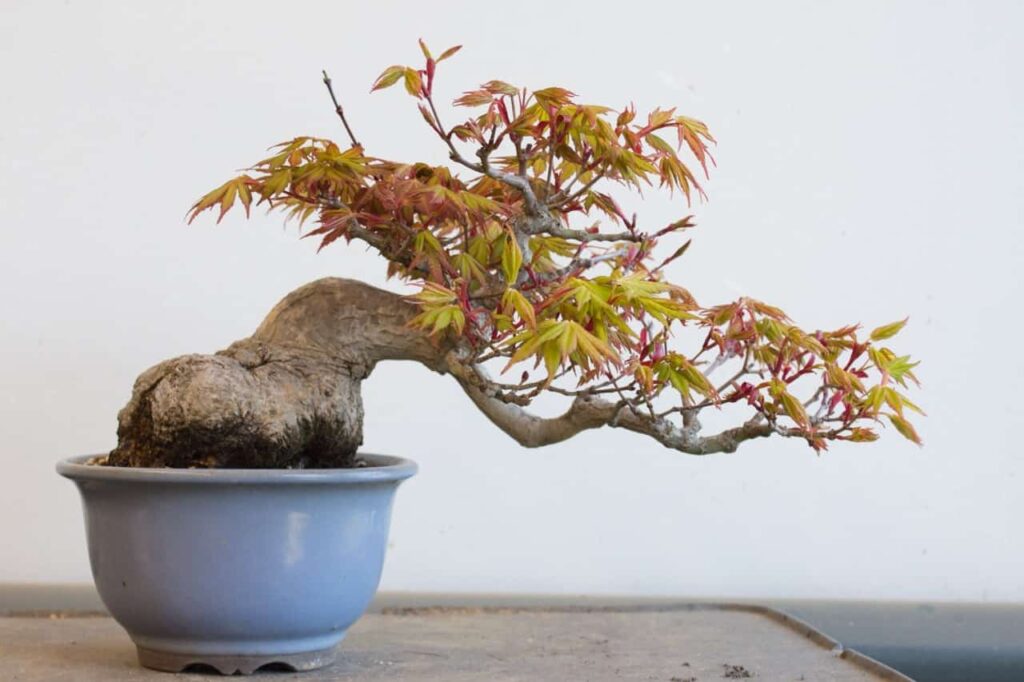
Japanese maple bonsai trees need 4 hours of partial sun and half shade and thrive mostly outdoors. Also, the plant grows best in the shade and the early morning sunlight.
Can you keep maple bonsai indoors?
Japanese maple bonsai don’t grow well indoors, like most bonsai trees. Japanese maple bonsai are best grown outdoors.
It is true that they are cold-hardy trees, but they can only tolerate short periods of freezing temperatures and should be protected from harsh winters.
Ideal Temperature and Humidity for Maple Bonsai
They thrive in bright, airy conditions. Nevertheless, if temperatures reach 30°C or higher, the leaves should be moved to an area with indirect sunlight.
Although it is frost-resistant bonsai, it should be protected from cold temperatures below -10°C. Also, it is important to protect them from harsh winter climates, even though they are cold-hardy.
When to wire a maple bonsai
The best time to wire a Japanese Maple Bonsai is in the summer when the tree has all its leaves. By wiring the tree, you can make it grow into the shape you desire.
As their branches are flexible and easily shaped, maple bonsai respond well to wiring. Moreover, make sure wires don’t remain on your tree for more than six months.
Japanese Maple Bonsai Winter Care
Cold and strong winds may damage your tree in winter. Additionally, maple bonsai need special care in January since it is India’s coldest month.
Hence, ensure it is sheltered outdoors. You may also need to insulate the roots. This can be accomplished by burying the pot in garden soil for the winter. Or you can wrap the pot in bubble wrap or burlap.
Additionally, you won’t need to water the tree much as it goes dormant; only water it when the soil dries out.
Conclusion
Maple Bonsai is an ideal plant to keep at home, especially if you are a plant enthusiast and plant lover. We hope this article has helped you understand the best way to care for your Maple Bonsai.
Please let us know in the comments section below if you have any questions regarding the care of your plants and we would love to help you out. Happy gardening!
Related Articles
- Propagating Chinese Elm Bonsai Cuttings And From Seeds
- Best Chinese Elm Bonsai Soil and Fertilizer.
- Troubleshooting Common Problems With Chinese Elm Bonsai
- Buy Chinese Elm Bonsai: How Not to Get Scammed When Purchasing a Chinese Elm Bonsai Tree!
- Chinese Elm Bonsai Pruning And Styling.
- Creating a Chinese Elm Bonsai Forest- Step-By-Step Guide.

